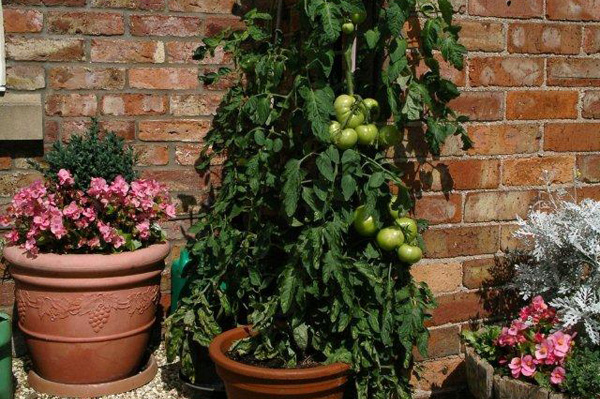Tomatoes are relatively easy to grow but can be affected by many problems, most of which are generally related to being cultivated in the same soil year after year. Old re-used soil is the main source of tomato plants disease and can cause you to have a whole crop of rotten tomatoes in the blink of an eye.
There are different ways of dealing with this problem, no one wants horrible diseased tomatoes when they can have a nice juicy crop by taking a few sensible precautions. Clearly the easiest way to avoid diseased soil is to use fresh compost each year which you can achieve by either using a growbag or some other sort of container.
Growing tomatoes in pots
Tomatoes will thrive in a standard 12″ plant pot as long as they are watered regularly and fed with a dilute liquid feed once or twice a week, particularly when the fruit starts to develop. Potassium supplements in the form of a high potassium tomato feed can aid the health and development of your plants and will be available from a garden center.
If you leave a space between the compost surface and the top of the pot, you can add more fresh compost as the plant develops and the compost shrinks.
The reason for using 12″ pots is that if the pots are too small the soil and compost mix can see erratic changes in both temperature and moisture, neither are conditions that the tomato plant will enjoy and will almost certainly lead to crop failure. Watering regularly so that the compost remains moist but not saturated is essential and this constant moisture content state is more easily achieved with larger pots. Remember as well that if you are using a growbag of around 40L not to put too many tomato plants per bag, my recommendation is 2 plants per bag and at a stretch perhaps 3 but definitely no more than that if you want decent results and healthy tomatoes.
Also make sure the plants (vine plants) are properly supported with either string, stakes or, more recently, tomato cages. If you are using string or stakes train the plants around them in a clockwise direction. Remove any little side shoots that develop between the main stem and the leaves, this should be done on a daily basis if possible.
When they are flowering you can gently tap the plants to help them pollinate, another option for aiding pollination is to spray with a fine mist of water when conditions are warm and bright. There is a further option of spraying with a hormone setting preparation which you can also get from the garden center, but tomatoes do pollinate quite readily so you shouldn’t really need to do this unless you are having problems.
When the fruit is beginning to ripen try and avoid temperatures over 27C (81F) especially if in a greenhouse where the glass can increase temperatures inside significantly. Potassium supplements in the form of a high potassium tomato feed can aid the health and development of your plants and again will be available from a garden center.
With indeterminate tomato plants you will need to limit the number of trusses that you allow to develop to between 4 and 6 depending on the length of the growing season wherever you are, or whether you are growing tomatoes in the greenhouse or outside.
Always remember to keep temperature and moisture levels constant, erratic changes can cause, flower shedding, blossom end rot, immature fruit fall, split skins, sun scald or blotchy ripening.
*Top Tip* Growers Pride is a great starter tomato for beginners, it is an F1 Hybrid however so you need to buy the plant or seeds rather than trying to grow them from seed you collect from a previous crop.
As a final word on growing tomatoes in pots, especially relevant when you have restricted space, is to do what a lot of people have started to do and that is to create an upside down tomato garden, where your tomato vine plant is planted in a plastic container and then hung upside down so that the vine hangs down instead of growing up a support frame. A little bit gimmicky I think, but then I suppose everyone to their own. I will make sure my next post describes how to do this.



Thanks for posting this article. I’ve picked up a few tips that I am going to put to use right away in my backyard raised garden.
Best Regards,
Mike